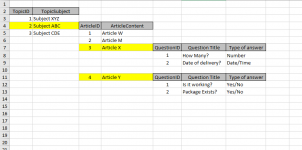alvingenius
IT Specialist
- Local time
- Today, 19:55
- Joined
- Jul 10, 2016
- Messages
- 169
Hello
I have this idea about a new project we are doing at my work
I'll try to describe it and I hope you get the idea
So at first lets say we have a main table called : Topics
Topics table have about 20 records

and i've another table that have a one to many relation with it called : Articles
So, every Topic, have many articles


next, i need to build another table/s that hae questions !, and it's again one to many relation with the articles table
i've write it in excel to show it to you

as you can see, the main table "" Topics "" and every topic have many articles and every article of every topic have a different question
So i don't know how to proceed with the questions table
Every topic can have different articles
so Topic id: 1 can have 20 articles, topic id : 2 can have 60 different articles ( I've no problem doing that till this step )
and every article can have 30-90 different questions than another article
So is there an easy way to build this questions table? what I think is I need to build massive numbers of questions tables based on every article on every topic
what do you think?
i'm attaching the example db i'm building for this project
thanks for helping
I have this idea about a new project we are doing at my work
I'll try to describe it and I hope you get the idea
So at first lets say we have a main table called : Topics
Topics table have about 20 records
and i've another table that have a one to many relation with it called : Articles
So, every Topic, have many articles
next, i need to build another table/s that hae questions !, and it's again one to many relation with the articles table
i've write it in excel to show it to you
as you can see, the main table "" Topics "" and every topic have many articles and every article of every topic have a different question
So i don't know how to proceed with the questions table
Every topic can have different articles
so Topic id: 1 can have 20 articles, topic id : 2 can have 60 different articles ( I've no problem doing that till this step )
and every article can have 30-90 different questions than another article
So is there an easy way to build this questions table? what I think is I need to build massive numbers of questions tables based on every article on every topic
what do you think?
i'm attaching the example db i'm building for this project
thanks for helping


